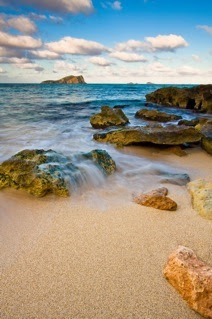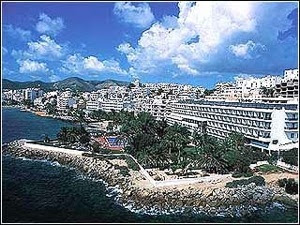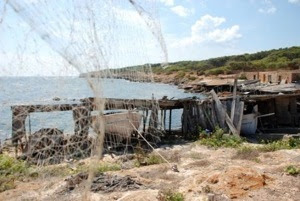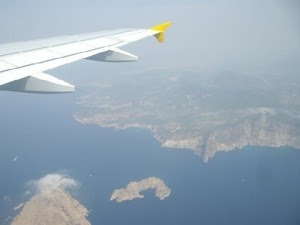IBIZA in the BALEARIC ISLANDS June 2002
MONDAY
I left Monday, June 10, 2002 at 10:50 a.m. flight NW 742
Arrived in Detroit 12:59 p.m. Departed Detroit 1:35 p.m. (flight 1867)
Arrived JFK 3:22 p.m.
Roundtrip from NYC (JFK) on Iberia Air Departed NYC at 6:25 p.m.
TUESDAY
Arrived Ibiza Tuesday, June 11.
Because of airline regulations I was not allowed to use my camcorder as we approached Ibiza. The coastline was beautiful from the air. The Island of Ibiza is the nearest of the Balearics to the coast of Spain. It was unknown and untouched by tourism until the 1960s, and it still has not lost its character. The majority of the island’s population live in the district of Ibiza which has almost 35,000 inhabitants.
On the map above Ibiza is spelled Eivissa.
A travel guide met me outside the customs area and escorted me to a shuttle bus.
Upon arrival at the four star Sol Molinos (Figuertas) Hotel, I taped the entrance level (3rd floor) and decorative waterfall. The hotel was actually located in the city of Figuertas, kind of a suburb of the city of Ibiza.
Before settling down, I videoed the outdoor swimming pool from the lobby balcony. The balcony offered comfortable seating areas for those who wanted to relax and soak in the view of the large pool, patio, and Mediterranean Sea in the background. I took the elevator down four levels to floor 0 which opened to a beautiful floral garden. The building complex here housed the indoor pool,
sauna, and exercise room. That evening, before dinner, I met Maria of the tourist agency who explained tours available on the island. I signed up for two tours.
At the hotel dinning room I ate my first of the magnificent meals provided in my Sun Holiday package.
WEDNESDAY
Breakfast buffet was quite comprehensive: Eight different kinds of bread plus rolls and croissants, different cereals, fruit, fruit drinks, eggs, bacon, sausage, ham, variety of cheese, etc. I started off my breakfast with apricot nectar and granola cereal and sat at a table with a nice view of the sea.
My first all day tour ($28, about 28 Euros, and well worth every cent) started with a trip to Las Salinas so I taped a map of the area. One of Ibiza’s famous landmarks are the salt flats, La Salinas, close to the airport on the southern-most tip of the island.
Our first stop en route was a pottery factory. As we exited the large bus, I took a shot of the fellow passengers and our capable tour guide (who spoke 5 languages). We observed a craftsman at a potter’s wheel who molded five different kinds of vases for us.
Then off to the Las Salinas region where we passed basins of salt. The salt pans have been in use for more than 2,000 years, since the earliest colonists, the Carthaginians, traded in the ‘white gold’ left in the pans when water evaporates in the hot summer months.
We walked out to the point here called Punta Rome that projected into the sea. Looking eastward across the bay was Punta de Portes with its ancient fortification tower. In the picture the tower can be seen in the upper left.
The nearby islands were called the Isles Negras. The flowers at Punte Rome were exceedingly beautiful so I took shots of three different varieties.
Driving inland, and upwards to the highest mountain in Ibiza, Sa Talaia, we came to the city of Sant Joseph with a population of about 14,000.
The parish church here was constructed to double as a fortification for protection from pirates. This explains why there were no windows on the lower level of the church. Later, as we saw other churches on the island, we noticed the similar style of architecture. The ornate interior of the church and the altar contrasted to the austere exterior.
After crossing the island we entered the city of San Antonio. Left side of map.
We drove along the quite lengthy beach that made the city a popular resort area. When the bus parked, our guide encouraged us to walk along the charming promenade of the beach front.
Some sun worshippers were topless in this PG 13 setting. Public nudity is legal in Spain, but by convention is usually limited to the beaches. Wearing swimming suits in supermarkets is usually frowned upon.
There was history here, too. I was impressed with the remains of a 19th century flour mill that had been arranged as a public monument.
A magnificent water fountain in San Antonio jetted water into the air with variations as if performing a symphony. A little lad watching it was captivated by the squirting water.
Heading inward again we passed through Sant Raphael (map), where we made a lunch stop. We ate at area where donkeys were penned in for visitors to pet. The picnic area or lunch pavilion can be seen in the background. For lunch I satisfied myself with a nice vegetable salad which cost less than four dollars.
From here we continued across the island to the opposite coast and the city of Es Cana. First on the agenda here was the opportunity to walk around in the Punta Arabi Hippy Market. This flea market type setting had its origin when hippies first came to the island as a retreat (and thus inadvertently starting a surge of tourism in the 60s). Many of the hippies turned to making craft items out of beads and stuff as a livelihood. Today not all the venders are real hippies, but some are related. The atmosphere is still there and it is more than a made-in-China outlet.
Just inside the entrance, with a banner overhead, we came a cross a living statue of a hippie. As I visited a number of the stalls I took some shots of the more unique ones. At one spot performers played music and danced in a 60s-like setting. I purchased a little wooded box with ”a bug” inside for only two Euros.
We regrouped at our bus at the appointed time and headed for the shoreline city of Eularia or Playa de Sant Eulalia (map on right).
The parish church Puig de Missa, dating back to the 12th century, was located on a high bluff and constructed in fortress style. I The church and the few surrounding structures are situated on the original site of the city. The sprawling resort city of 20,000 inhabitants now capitalizes on the sandy beach here.
Only steps from where I video taped the church was a nice promenade that our guide encouraged us to walk. Sun worshippers were spread out along the sandy beach. After my walk I took in a nice tomato and onion salad for less than four dollars. I ate such a light lunch in anticipation of the feast-like dinner later back at Los Molinos Hotel.
On a way out of town we passed over the only river on Ibiza. To our left was the old 19th century bridge which still had parts from the bridge of 2,000 years ago. Later, as we approach the city of Ibiza we could see the landmark Dalt Vila or old fortress of the city.
After a nice full meal at the hotel, I went up to my room and retired early. It was a good profitable day, but a busy one. That was one of the best tours I have taken.
THURSDAY
My major activity of the day would be walking around the Dalt Vila on my own. The old quarters of Eivissa (Ibiza city) is known as the Dalt Vila or upper town. It is a miniature citadel guarding the almost circular bay. The old fortress is surrounded by Renaissance walls. I taped a map showing my walking trail from the Los Molinos Hotel (red pin on map) on Ramon Muntanar to Avenue Espana (in yellow) and then right on Via Romana first main street) to the fortress. The round about way was dictated by the mountain terrain, Fifteen minute walk.
From Parc De La Reina Soria I entered the fortress through a stone tunnel.
I climbed the steep ascent of Ronda De Joan Baptista Calm (San Bautista on map). Along the walkway were beautiful flower gardens. Looking down from the fortified wall of Baqlvard De Sant Jaume I could see (and hear) school children playing. Further on I videoed the view of the sea and islands from Balvard De Sant Jordi (Bastion on bottom of map). Continuing my walk on to Balvard De Sant Bernat (Bastion San Bernardo on map), I had a nice view of the Cathedral.
Crowning the whole Dalt Vila, and visible for miles around, was this old Cathedral, a 13th century Catalan Gothic building with 18th century additions. The cathedral’s Museo de la Sacristia houses assorted works of art and the main portion of the Castle. The University of Ibiza (government house) was situated by the cathedral until it was abolished in the 18th century by the Spanish Bourbon king.
The pipe organ in the back of the church was quite attractive.
Adjacent to the cathedral was the Museu Arqueolgic. There was an admission charge, but I was allowed in free because I was over 65. The excellent exhibits spanned the periods from the Phoenicians, the Carthaginians (654 BC), Romans (146 BC-476 AD), Byzantine (835-682), Visigoths, Arabs, Spanish Aragon (1234) and Catalans.
Outside the museum I videoed a view of Sa Penya and the harbor. Sa Penya was where the sailors and fishermen of past years had lived. I also shot the quaint narrow street of Santa Maria by the museum and a nearby residence that had been inhabited by a wealthy aristocrat.
I next visited the Ajuntament of the Convent of Sant Domence. Here was the 16th century Esglesia de Santo Domingo with its three red tiled domes. The baroque interior, with its barrel-vaulted ceiling and frescoed walls, has been restored to its former glory.
Towards the end of my self guided tour I walked through the Romanesque vestibule and parade grounds to the Portals Des Saules. The Portal Des Saules, a magnificent gateway in the north wall of the 16th century fortification, carries the finely carved coat of arms of the kingdom of Aragon -- to which the Balearic Islands belonged in the Middle Ages. This monumental coat of arms belonged to Philip II and is flanked by two Roman marble statues. Outside the gate was a drawbridge and a long stone walkway leading up to it.
A Roman style open market building on Constitution Square was bustling with activity of fruit and vegetable merchants. Since it was lunchtime I purchased a snack of boysenberries and a banana for a total of around four dollars. As I left the old town I encountered a living “statue” of a woman blowing bubbles.
FRIDAY
Today was a day set aside for a trip to Formentera, the smallest of the Balearic Isles. Bus D11 picked me up at 9 a.m. and we headed for the docking area off of old town. Here we boarded our boat for the 45 minute trip southward. The craft was such that no one could be on deck for the trip. All seating was like that of a 747, comfortable, but confining. After leaving the harbor we came across the fortress type tower (Torre) on Puma De Ses Salinas guarding the tip of Ibiza.
As we approached Formentera we could see the lighthouse of Ses Palm A Dor through the steamed up windows of our boat.
Our docking area was at San Francisco, the largest city on the island, where we boarded another tour bus. We traversed the island on the single main highway on Formentera and passed quaint stone enclosed farms along the countryside.
Our bus stopped at a lookout point so we could see Ibiza off in the distance and the coastal are of Formentera below us. The view was great from this spot on Mt. La Mola, the highest point on the island.
When we reached the southern-most tip of Formentera (“the end of the world”) we encountered the famous lighthouse Punta D’Esfard. We were on a high bluff overlooking the Mediterranean Sea. In this scenic setting I indulged in a light dessert cake that was popular on the island. Cost about $1.80.
Our return trip back across the island took us past more farms enclosed with stone fences and an historic fishermen’s village at De Calo.
Ramp for fishing boats.
At San Francisco we were given a city tour which included the Church of San Francisco, the largest church on the island. The architecture reflected its duel purpose as a fortress to fend off corsairs. Excited children on a school trip also occupied the square and marketplace in front of the church.
After free time to roam the city we boarded the bus and headed for the beach at San Fernando called EsPujols. Free time allowed us to walk the promenade or join the sunbathers on the sandy beach. A couple on our bus headed for the sand and parked themselves along side a young PG13 rated sunbather. I found a nice eating place on the promenade and relaxed with a lunch of tomato and onion salad ($3.80, which included bread) and a glass of cold tap beer.
After a nice lengthy sojourn here at Es Pujols, we headed back on a high speed ferry to Ibiza and the Dalt.
SATURDAY
Today was a day of leisure. Leaving Los Molinos beach front, I walked along the connecting promenade. An artist had sculpted three monkeys in the sand -- see no evil, hear no evil, and speak no evil. Sand sculpture pieces of art were found on just about any beach -- with a nearby cup suggesting donations. On this picture, the background is part of my hotel’s waterfront.
I then ventured over to the main street of Avenue of Espana and meandered toward the Old Town. Like Saturday nights everywhere young people turned out with their dates. The thermometer read 35 degrees so I knew it was warmer than usual. Naturally this required a cold beer in the shade. At nightfall I returned to the Sol Molinos.
SUNDAY
Another day for leisure and walking about the promenade and the streets of Old Town. I passed a sign Molinos with the picture of mills. The citizens of Cartage deemed it an honor to be buried at the Necropolis of Puig d’es Molin, thought to contain over 4,000 graves. The waterfront was cooler with a nice breeze coming in from the Mediterranean Sea. A fisherman statue reminded me that this fishing community. At noon I had my usual salad and a cold glass of Estrella at a cafe outside the Hotel Montesoi (one of the first hotels on the island). Renewed with energy I explored more of Old Town along the castle wall.
MONDAY
Early departure to Barcelona. Last view of Ibiza from the air. Short fight to Madrid. Flight across the Atlantic to JFK on a Iberian Air Bus.
Another great Spanish tour!
Cost: Air, hotel and meals was around
$1200 with my AARP 6% discount.
Sun Holiday Travel special

















































